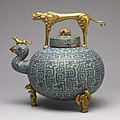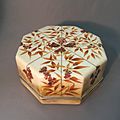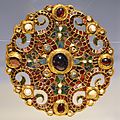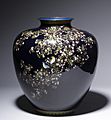Cloisonné facts for kids
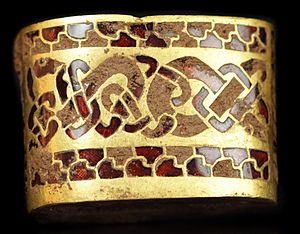
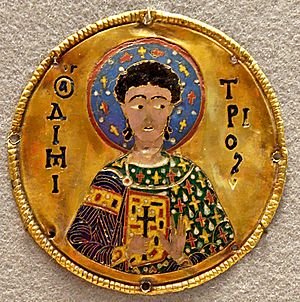
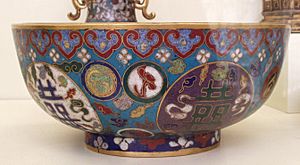
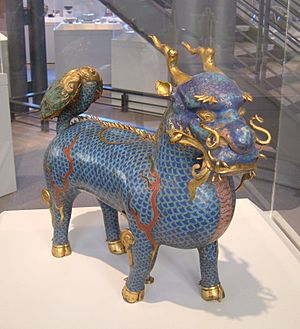
Cloisonné (say "kloy-zon-nay") is a French word meaning "enclosed." It is an ancient way to decorate metal objects. The objects made using this technique are also called cloisonné.
Contents
What is Cloisonné?
This special decoration is made by adding small sections or "cells" to a metal object. Think of them like tiny walls.
How it's Made
First, thin wires or strips of silver or gold are placed on their edges. These wires are then soldered (or stuck) onto the metal surface. These wires create the compartments. You can still see these wires in the finished artwork. They separate the different coloured areas.
The most common material used to fill these cells is coloured enamel. Enamel is like a type of glass. To make cloisonné enamel objects, a powder of enamel is mixed with water to make a paste. This paste is then carefully placed into each tiny cell. After the cells are filled, the object is heated in a very hot oven called a kiln. This melts the enamel, making it smooth and shiny. In very old times, instead of enamel, people sometimes used small, cut gemstones to fill the compartments.
History of Cloisonné
This technique was first used a very long time ago.
Early Uses
In ancient times, cloisonné was mostly used for jewellery and small decorations. These could be small parts for clothes, weapons, or other tiny items. The designs were often simple shapes or patterns. The wire walls (called cloisons) were usually quite thick. The oldest known cloisonné pieces are rings. They were found in graves in Cyprus and date back to the 12th century BC. These early pieces used very thin wires.
Spread and Development
Later, in the Byzantine Empire, people developed a way to use even thinner wires. This allowed artists to create detailed pictures and images. In the Byzantine Empire, cloisonné was mainly used for religious pictures and jewellery. By this time, enamel was always the filling material. By the 14th century, this enamel technique traveled to China. There, it became very popular for decorating much larger items. These included big bowls and beautiful vases. The cloisonné technique is still very common in China today. From the 18th century onwards, Western artists also started making cloisonné objects. They often used styles inspired by Chinese designs.
Images for kids
-
This is a pectoral (a chest ornament) of Senusret II. It uses shaped stones like carnelian, feldspar, garnet, turquoise, and lapis lazuli instead of enamel. It's from his daughter's grave, made around 1880 BC.
-
A French mirror-back from the 16th century. It combines cloisonné with plique-à-jour (a type of enamel work) backed onto glass or rock crystal.
-
The Khalili Imperial Garniture. This was made in Japan during the Meiji period. At the time, it was the largest cloisonné enamel piece ever made. It was shown at the World's Columbian Exposition in 1893.
-
A Tea caddy made of silver gilt with opaque raised cloisonné enamel. It was made by the House of Fabergé in Russia before 1896.
-
The Dorestad Brooch, made around 800 AD. It was found in the Netherlands. It is made of gold and pearls, with cloisonné almandine (a type of garnet), enamel, and glass.
-
A pair of Visigothic 6th-century eagle-fibulae (brooches) from Spain. They have garnets, amethysts, and coloured glass. Some of the cloisons are now empty.
-
A plaque with Saint Peter from the Holy Crown of Hungary. It shows a special technique.
-
A Chinese shrine for a Bodhisattva, made between 1736 and 1795. The shrine is cloisonné enamel on copper alloy, and the figure is copper with gems.
-
A Qing dynasty cloisonné dish.
-
A matching pair of Cloisonné Vases, made between 1800 and 1894. They are from the Oxford College Archives of Emory University.
-
A Kyoto Cloisonne Enamel vase, made by Namikawa Yasuyuki (1845–1927).
-
A Tokyo Cloisonne Enamel bowl, called Shōtai Shippō, made by Namikawa Sōsuke around 1900. It is translucent plique-a-jour enamel on silver.
-
A Harley-Davidson "100th Anniversary" fuel tank with "cloisonné" decoration, from a 2003 Dyna Low Rider motorcycle.
See also
 In Spanish: Esmalte alveolado para niños
In Spanish: Esmalte alveolado para niños





